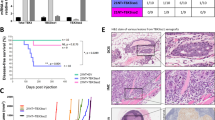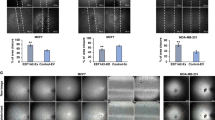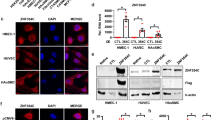Abstract
Runx transcription factors regulate viral growth, hematopoiesis, bone formation, angiogenesis, and gastric epithelial development through specific DNA-binding motifs on target gene promoters. Vascular endothelial cells (ECs) express RUNX genes that are activated by angiogenic factors. The RUNX2 gene also activates the vascular endothelial growth factor promoter. Alternatively spliced forms of RUNX genes have been described, but their functions in angiogenesis have not been elucidated. In this study, expression of a novel alternatively spliced variant of RUNX2 (RUNX2Δ8), lacking the region encoded by exon 8, was detected in aortic tissue undergoing angiogenesis in vitro and in ECs. Expression of RUNX2 and RUNX2Δ8 increased in vascular sprouts concomitant with expression of cellular proteases and cytokines known to mediate angiogenesis. RUNX2 DNA-binding activity was expressed in proliferating but not quiescent ECs. Ectopic expression of RUNX2 in ECs increased cell sprouting, cell proliferation, DNA synthesis, and phosphorylation of phosphorylated retinoblastoma relative to control transfectants while RUNX2, but not RUNX2Δ8 transfectants, acquired resistance to growth inhibition by transforming growth factor (TGFβ1). Furthermore, RUNX2Δ8-transfected cells were more sensitive to TGFβ1-induced apoptosis than RUNX2 transfectants. Consistent with these data, the RUNX2 gene was a strong repressor of the promoter of the cyclin-dependent kinase inhibitor, p21CIP1, while RUNX2Δ8 was a competitive inhibitor of RUNX2 and exhibited weak repression activity. These results support the hypothesis that ECs regulate growth and apoptosis, in part, by alternative splicing events in the RUNX2 transcription factor to affect the TGFβ1 signaling pathway. The exon 8 domain of RUNX2 may contribute to the strong repression activity of RUNX2 for some target gene promoters.
This is a preview of subscription content, access via your institution
Access options
Subscribe to this journal
Receive 50 print issues and online access
$259.00 per year
only $5.18 per issue
Buy this article
- Purchase on Springer Link
- Instant access to full article PDF
Prices may be subject to local taxes which are calculated during checkout








Similar content being viewed by others
Abbreviations
- EC:
-
endothelial cell
- TGFβ1:
-
transforming growth factor-β
- VEGF:
-
vascular endothelial growth factor
- FGF:
-
fibroblast growth factor
- IGF-1:
-
insulin-like growth factor-1
- RHD:
-
Runt homology domain
- uPA:
-
urokinase plasminogen activator
- NF-κB:
-
nuclear factor-κB
- CP:
-
cyclophilin
- MT1-MMP:
-
membrane-type metalloproteinase-1
- EMSA:
-
electrophoretic mobility-shift assay
- BAEC:
-
bovine aortic endothelial cells
- HBME:
-
human bone marrow endothelial cells. RUNX2 indicates the human gene whereas Runx2 indicates the mouse gene. In reference to general cases, Runx is used
References
Alexandrow MG, Kawabata M, Aakre M and Moses HL . (1995). Proc. Natl. Acad. Sci. USA, 92, 3239–3243.
Asahara T, Bauters C, Zheng LP, Takeshita S, Bunting S, Ferrara N, Symes JF and Isner JM . (1995). Circulation, 92, II365–II371.
Baltzinger M, Mager-Heckel AM and Remy P . (1999). Dev. Dyn., 216, 420–433.
Beck Jr L and D'Amore PA . (1997). FASEB J., 11, 365–373.
Blyth K, Terry A, Mackay N, Vaillant F, Bell M, Cameron ER, Neil JC and Stewart M . (2001). Oncogene, 20, 295–302.
Bravo J, Li Z, Speck NA and Warren AJ . (2001). Nat. Struct. Biol., 8, 371–378.
Burchardt M, Burchardt T, Chen MW, Shabsigh A, de la Taille A, Buttyan R and Shabsigh R . (1999). Biol. Reprod., 60, 398–404.
Carmeliet P and Collen D . (2000). J. Pathol., 190, 387–405.
Claassen GF and Hann SR . (2000). Proc. Natl. Acad. Sci. USA, 97, 9498–9503.
Datto MB, Li Y, Panus JF, Howe DJ, Xiong Y and Wang XF . (1995). Proc. Natl. Acad. Sci. USA, 92, 5545–5549.
Ducy P, Zhang R, Geoffroy V, Ridall AL and Karsenty G . (1997). Cell, 89, 747–754.
el-Deiry WS, Tokino T, Velculescu VE, Levy DB, Parsons R, Trent JM, Lin D, Mercer WE, Kinzler KW and Vogelstein B . (1993). Cell, 75, 817–825.
Ferrara N . (2000). Recent Prog. Horm. Res., 55, 15–35; discussion 35–6.
Flaumenhaft R, Abe M, Mignatti P and Rifkin DB . (1992). J. Cell. Biol., 118, 901–909.
Folkman J . (1995). Nat. Med., 1, 27–31.
Gartel AL and Tyner AL . (1999). Exp. Cell Res., 246, 280–289.
Geoffroy V, Corral DA, Zhou L, Lee B and Karsenty G . (1998). Mamm. Genome, 9, 54–57.
Gothie E, Richard DE, Berra E, Pages G and Pouyssegur J . (2000). J. Biol. Chem., 275, 6922–6927.
Hanahan D . (1997). Science, 277, 48–50.
Hata-Sugi N, Kawase-Kageyama R and Wakabayashi T . (2002). Biol. Pharm. Bull., 25, 446–451.
Hiraoka N, Allen E, Apel IJ, Gyetko MR and Weiss SJ . (1998). Cell, 95, 365–377.
Huang YQ, Li JJ and Karpatkin S . (2000). Blood, 95, 1993–1999.
Ito Y . (1999). Genes Cells, 4, 685–696.
Ito Y and Miyazono K . (2003). Curr. Opin. Genet. Dev., 13, 43–47.
Jakubowiak A, Pouponnot C, Berguido F, Frank R, Mao S, Massague J and Nimer SD . (2000). J. Biol. Chem., 275, 40282–40287.
Kalluri R and Sukhatme VP . (2000). Curr. Opin. Nephrol. Hypertens, 9, 413–418.
Kerbel RS . (2000). Carcinogenesis, 21, 505–515.
Koff A, Ohtsuki M, Polyak K, Roberts JM and Massague J . (1993). Science, 260, 536–539.
Komori T, Yagi H, Nomura S, Yamaguchi A, Sasaki K, Deguchi K, Shimizu Y, Bronson RT, Gao YH, Inada M, Sato M, Okamoto R, Kitamura Y, Yoshiki S and Kishimoto T . (1997). Cell, 89, 755–764.
Kriventseva EV, Koch I, Apweiler R, Vingron M, Bork P, Gelfand MS and Sunyaev S . (2003). Trends Genet., 19, 124–128.
Laiho M, DeCaprio JA, Ludlow JW, Livingston DM and Massague J . (1990). Cell, 62, 175–185.
Lehr JE and Pienta KJ . (1998). J. Natl. Cancer Inst., 90, 118–123.
Li WW . (2000). Acad. Radiol., 7, 800–811.
Li QL, Ito K, Sakakura C, Fukamachi H, Inoue KI, Chi XZ, Lee KY, Nomura S, Lee CW, Han SB, Kim HM, Kim WJ, Yamamoto H, Yamashita N, Yano T, Ikeda T, Itohara S, Inazawa J, Abe T, Hagiwara A, Yamagishi H, Ooe A, Kaneda A, Sugimura T, Ushijima T, Bae SC and Ito Y . (2002). Cell, 109, 113–124.
Linggi B, Muller-Tidow C, van de Locht L, Hu M, Nip J, Serve H, Berdel WE, van der Reijden B, Quelle DE, Rowley JD, Cleveland J, Jansen JH, Pandolfi PP and Hiebert SW . (2002). Nat. Med., 8, 743–750.
Lund AH and Van Lohuizen M . (2002). Cancer Cell, 1, 213–215.
Lutterbach B, Westendorf JJ, Linggi B, Isaac S, Seto E and Hiebert SW . (2000). J. Biol. Chem., 275, 651–656.
Lyons RM and Moses HL . (1990). Eur. J. Biochem., 187, 467–473.
Maisonpierre PC, Suri C, Jones PF, Bartunkova S, Wiegand SJ, Radziejewski C, Compton D, McClain J, Aldrich TH, Papadopoulos N, Daly TJ, Davis S, Sato TN and Yancopoulos GD . (1997). Science, 277, 55–60.
Massague J and Wotton D . (2000). EMBO J., 19, 1745–1754.
Nagata K . (1996). Trends Biochem. Sci., 21, 22–26.
Namba K, Abe M, Saito S, Satake M, Ohmoto T, Watanabe T and Sato Y . (2000). Oncogene, 19, 106–114.
Newton LK, Yung WK, Pettigrew LC and Steck PA . (1990). Exp. Cell Res., 190, 127–132.
Ngo CV, Gee M, Akhtar N, Yu D, Volpert O, Auerbach R and Thomas-Tikhonenko A . (2000). Cell Growth Differ., 11, 201–210.
Nicosia RF, Nicosia SV and Smith M . (1994). Am. J. Pathol., 145, 1023–1029.
Nicosia RF and Ottinetti A . (1990). Lab. Invest., 63, 115–122.
Nicosia RF and Tuszynski GP . (1994). J. Cell. Biol., 124, 183–193.
Nor JE, Christensen J, Mooney DJ and Polverini PJ . (1999). Am. J. Pathol., 154, 375–384.
Ogawa E, Inuzuka M, Maruyama M, Satake M, Naito-Fujimoto M, Ito Y and Shigesada K . (1993). Virology, 194, 314–331.
Otto F, Thornell AP, Crompton T, Denzel A, Gilmour KC, Rosewell IR, Stamp GW, Beddington RS, Mundlos S, Olsen BR, Selby PB and Owen MJ . (1997). Cell, 89, 765–771.
Pepper MS, Belin D, Montesano R, Orci L and Vassalli JD . (1990). J. Cell. Biol., 111, 743–755.
Perry C, Sklan EH, Birikh K, Shapira M, Trejo L, Eldor A and Soreq H . (2002). Oncogene, 21, 8428–8441.
Pollman MJ, Naumovski L and Gibbons GH . (1999). J. Cell Physiol., 178, 359–370.
Rabbani SA . (1998). In Vivo, 12, 135–142.
Riccioni T, Cirielli C, Wang X, Passaniti A and Capogrossi MC . (1998). Gene Ther., 5, 747–754.
Risau W and Flamme I . (1995). Annu. Rev. Cell Dev. Biol., 11, 73–91.
Roninson IB . (2002). Cancer Lett., 179, 1–14.
Sato Y . (2000). Pharmacol. Ther., 87, 51–60.
Selvamurugan N, Pulumati MR, Tyson DR and Partridge NC . (2000). J. Biol. Chem., 275, 5037–5042.
Smith JS . (2002). Trends Cell Biol., 12, 404–406.
Smith CWJ and Valcarcel J . (2000). TIBS, 25, 381–388.
Sorek R and Amitai M . (2001). Nat. Biotechnol., 19, 196.
Stewart M, Terry A, Hu M, O'Hara M, Blyth K, Baxter E, Cameron E, Onions DE and Neil JC . (1997). Proc. Natl. Acad. Sci. USA, 94, 8646–8651.
Sun L, Vitolo M and Passaniti A . (2001). Cancer Res., 61, 4994–5001.
Taipale J and Keski-Oja J . (1997). FASEB J., 11, 51–59.
Takakura N, Watanabe T, Suenobu S, Yamada Y, Noda T, Ito Y, Satake M and Suda T . (2000). Cell, 102, 199–209.
Takeichi H, Hosokawa N, Hirayoshi K and Nagata K . (1994). Mol. Cell. Biol., 14, 567–575.
Tischer E, Mitchell R, Hartman T, Silva M, Gospodarowicz D, Fiddes JC and Abraham JA . (1991). J. Biol. Chem., 266, 11947–11954.
Vaillant F, Blyth K, Terry A, Bell M, Cameron ER, Neil J and Stewart M . (1999). Oncogene, 18, 7124–7134.
Wang W and Passaniti A . (1999). J. Cell Biochem., 73, 321–331.
Westendorf JJ and Hiebert SW . (1999). J. Cell Biochem., 32/33, 51–58.
Westendorf JJ, Zaidi SK, Cascino JE, Kahler R, van Wijnen AJ, Lian JB, Yoshida M, Stein GS and Li X . (2002). Mol. Cell. Biol., 22, 7982–7992.
Xiao G, Jiang D, Thomas P, Benson MD, Guan K, Karsenty G and Franceschi RT . (2000). J. Biol. Chem., 275, 4453–4459.
Xiao ZS, Thomas R, Hinson TK and Quarles LD . (1998). Gene, 214, 187–197.
Yang C, Chang J, Gorospe M and Passaniti A . (1996). Cell Growth Differ., 7, 161–171.
Zelzer E, Glotzer DJ, Hartmann C, Thomas D, Fukai N, Soker S and Olsen BR . (2001). Mech. Dev., 106, 97–106.
Zhang YW, Bae SC, Takahashi E and Ito Y . (1997). Oncogene, 15, 367–371.
Acknowledgements
We thank Dr Yoshiaki Ito for providing the PEBP2aA (RUNX2) cDNA clone, Dr Bert Vogelstein for the p21CIP1-promoter vector, Mr. Jay Hunter for laboratory management, and Dr Jeffrey Hasday for his helpful comments in the preparation of the manuscript. This study was supported, in part, by an American Heart Association Grant-in-Aid (AHA 0151434U) and a National Institutes of Health grant (CA95350-01) to A.P. Michele Vitolo is the recipient of an American Heart Association Pre-doctoral Fellowship (AHA 0215217U).
Author information
Authors and Affiliations
Corresponding author
Rights and permissions
About this article
Cite this article
Sun, L., Vitolo, M., Qiao, M. et al. Regulation of TGFβ1-mediated growth inhibition and apoptosis by RUNX2 isoforms in endothelial cells. Oncogene 23, 4722–4734 (2004). https://doi.org/10.1038/sj.onc.1207589
Received:
Revised:
Accepted:
Published:
Issue Date:
DOI: https://doi.org/10.1038/sj.onc.1207589
Keywords
This article is cited by
-
The synergistic effects of TGF-β1 and RUNX2 on enamel mineralization through regulating ODAPH expression during the maturation stage
Journal of Molecular Histology (2022)
-
Differential expression and regulation of Runx1 in mouse uterus during the peri-implantation period
Cell and Tissue Research (2015)
-
In vitro anti-angiogenic properties of LGD1069, a selective retinoid X-receptor agonist through down-regulating Runx2 expression on Human endothelial cells
BMC Cancer (2011)
-
Cancer-related ectopic expression of the bone-related transcription factor RUNX2 in non-osseous metastatic tumor cells is linked to cell proliferation and motility
Breast Cancer Research (2010)
-
Elevated AKR1C3 expression promotes prostate cancer cell survival and prostate cell-mediated endothelial cell tube formation: implications for prostate cancer progressioan
BMC Cancer (2010)



